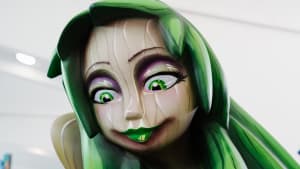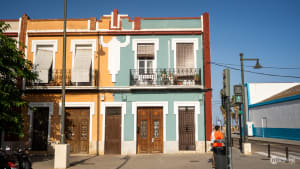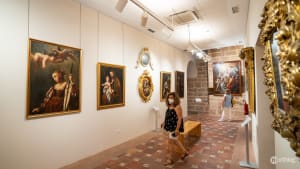
Interesting Facts About Valencia
A few of the most curious and fun facts about Valencia, to get acquainted with this marvellous Mediterranean city.
Interesting facts about Valencia in a nutshell...
Valencia blends rich history with modern flair through unique transformations and achievements.
After a devastating 1517 flood, the city turned its riverbed into the lush 10km Turia Park instead of building a highway. It’s home to the Holy Grail, Europe’s largest aquarium (Oceanogràfic), and the continent’s narrowest building, La Estrecha (just 107cm wide).
Known as the birthplace of paella and home to Europe’s largest fresh produce market, Valencia also pioneered the first public bank and hosts the world’s oldest functioning court, the Water Tribunal, meeting weekly since medieval times.
Cultural highlights include the fiery UNESCO-listed Fallas festival, Calatrava’s iconic City of Arts and Sciences, and a brief role as Spain’s capital during the Civil War. Locals celebrate love with marzipan on October 9th, and the city’s symbol (a bat) honors the creature said to have saved King Jaume I in 1238.
Valencia is a city that never ceases to surprise. Nestled on Spain’s sunny Mediterranean coast, it effortlessly blends ancient traditions with bold modernity. From housing the legendary Holy Grail to transforming a once-destructive river into a sprawling green park, Valencia thrives on reinvention.
It’s the birthplace of paella, the stage for the fiery Fallas festival, and home to architectural wonders and quirky records alike.
Whether you’re a curious traveler or a history buff, these fascinating facts will give you a glimpse into what makes Valencia truly one of a kind.
The River Park
Valencia’s Turia Park, a lush urban garden of 110 hectares (about 272 acres) lies on what used to be the old Turia’s riverbed - hence the name of the Park. The park snakes through Valencia for almost 10 km (about 6 miles), hugging the city’s old quarters. Because of this, you’ll hear Valencianos often call the Park rio, meaning river.

Through the centuries, the Turia river brought Valencia prosperity but also hardship. In the Middle Ages, whenever there was a flood, the waters would inundate the surrounding area and its houses. The worst flood ever recorded happened in 1517 when, after 40 days of rain, the uncontrollable river washed away bridges and around 200 houses.
After many other floods, at the end of the 20th century, drastic changes had to be made to avoid what was becoming a routine tragedy. Thus, the river was diverted from the city in 1969.
The government at the time wanted to repurpose the old riverbed into a highway, but the citizens protested the proposal so much that by the end of the ‘70s, the city accepted turning the riverbed into a park. In 1986, the park today known as Parque del Turia was completed and opened to the citizens.
The Holy Grail
The Holy Chalice, or Holy Grail, is probably the most famous and sought-after Christian relic. According to religious tradition, and its many written references, the Chalice is the cup from which Jesus drank at the Last Supper. The very ritual of the Eucharist - where the priest offers his disciples wine from a cup - is a reference to this incident.

Well, according to the Roman Catholic Church, the Holy Grail is kept right here in Valencia’s Cathedral. The story of how the Chalice got to Valencia’s Cathedral is heavily debated, but the itinerary should be something like the following.
The goblet used by Jesus was taken from Jerusalem to Rome. From there, hundreds of years later, it was taken to Aragón, in Spain, and hidden in various monasteries. Finally, in the 1400s, it arrived in Valencia in the hands of the King Alfonso V of Aragon.
Paella’s Hometown
As you will surely have heard, Valencia is the birthplace of Spain’s most well-known dish, paella (pronounced pah-eh-ya). The dish was conceived by the freshwater lagoon of the Albufera, just outside Valencia.

While there are many, all equally delicious, variations of the dish, the original recipe calls for chicken, rabbit, lima beans and sometimes snails. Peas, red peppers, and chorizo are all non-original ingredients, albeit very tasty.
Biggest Market in Europe
Valencia, like the majority of Spanish cities, has numerous covered markets. But something no other city in the country has is Europe’s largest fresh produce market, the Mercado Central (the Central Market).

However, this is not the only record the market holds: it was also the world’s first market to accept online orders and offer home delivery to its customers. The Mercat has also been listed as one of the most beautiful markets in the world by recognised institutions, like the BBC , but you’ll see that yourself as soon as you step in.
The Mercado Central is an Art-Nouveau cathedral of produce. Wrought iron, stained glass, and ceramics rise above hundreds of local products, fragrant fruits and fresh vegetables, aromatic spices and local specialities.
Fallas
The Fallas festival is a traditional festivity held every year between the end of February and the 19th of March in Valencia. The people of the city - organised in numerous committees - plan, design, and fundraise for a year. Finally, as spring rolls around, the festival is brought to life.

During this time, Valencia is witness to an intense programme, filled with ceremonies, flower offerings, parades, firework displays, the construction of huge wooden sculptures, and a final, unforgettable bonfire. The result is so grand and unique that Falles was recognised as Intangible Cultural Heritage by UNESCO .
The Last Spanish Inquisition Execution
Unfortunately, there are many bloody chapters in Spanish history, and the one about the Spanish Inquisition found its last page right here in Valencia. In 1826, after almost 350 years of activity, the Inquisition demanded its last execution.

Gaietà Ripoll, a schoolmaster in Valencia, was accused of heresy and condemned to burn at the stake. However, civil authority intervened and chose to hang him in the square where the Mercado Central is today located.
The Largest Aquarium in Europe
Part of the City of Arts and Sciences complex, the Oceanogràfic, is the largest aquarium in Europe. The aquarium, seemingly floating like a pond flower over the surrounding waters, is actually made up of several underwater halls, all connected through floating walkways and gardens.

The building is home to around 45,000 animals from 500 different species, including penguins, dolphins, giant tortoises, beluga whales, and crocodiles.
The Narrowest Building in Europe
Another record for Valencia, although this one could be hard to spot. The narrowest building in Europe - second narrowest in the world - is here, and it’s aptly called La Estrecha (the narrow one). You will find it in Plaza Lope de Vega, just a few steps away from the Lonja de la Seda.

The construction - wedged between two beautiful apartment complexes - barely looks like its own building at a first glance, as it is barely wide enough to have a door and a column of windows right above it. The building is only 107 cm wide (3.5 feet) and 5 storeys tall.
The reason for its construction is rather funny. Back in the day, property taxes were based on the size of the façade, so the reduced width was simply a way to lower the taxes.
Capital of Spain
During the Spanish Civil War, in 1936, Valencia was briefly appointed capital of Spain. The title only lasted for 11 months, but the Republican government took refuge in the city and the Lonja de la Seda was used to hold meetings of the Spanish Parliament.
City of crocodiles
Even though Valencia enjoys a pretty warm climate year-round, it definitely cannot be described as a tropical city. So it might surprise you to find out that there is a considerable amount of legends regarding crocodiles in Valencia. Given, the legends are only a couple, but that is still two more than what you would expect from a European city.

According to the first one, a shapeshifting cayman used to live on the old Turia riverbed, terrifying the population. The beast would turn into a terrible dragon and butcher the fools who tried to approach it. That is, until a brave soul, suited up in an armour covered with mirrors confronted the cayman.
Either blinded by the mirrors’ reflections or hypnotised by them, the dragon-cayman was killed, and its reptilian body rests today in the Iglesia del Patriarca. In reality, the creature in the Patriarca’s Church is just a stuffed cayman from Peru, donated in 1606 by the Marquis of Monterrey. The myth was even portrayed by local author Blasco Ibáñez in his book The Dragon and the Patriarch.
Another curious story has to do with the basement of the Mercat Central. For years, many claimed that when night fell and the hustle and bustle of customers and merchants died down, weird noises could be heard coming from down below.
The suspicions were that an enormous crocodile was hiding in the dark market basement. The rumours were over time dispelled, not without many claiming to even have seen the creature. Unfortunately, today the Mercat doesn’t even have a stuffed crocodile to support its legend.
The Busiest Cargo Port in Spain
Valencia is not only a beautiful and thriving city, but it is also one of the most important cities in the Spanish economy. In fact, it is home to the busiest cargo port in Spain and the Mediterranean area, fifth in Europe and thirtieth worldwide.

Valencia’s port alone is said to generate more than half of Spain’s GDP. This calculation is made on the basis that half of the country’s working population has some kind of connection to it.
Safehouse
During the Spanish Civil War (1936-1939), the Serranos Towers were used to keep several artworks from Madrid’s Prado Museum safe, in case of bombing. Among them was even Velázquez’ f amous Las Meninas . Of course, measures had to be taken to prevent damage to the pieces.

First of all, the paintings were placed on the lowest floor, to avoid damage in case of collapse. A vault was then built over this floor. This consisted of a 90-cm layer (about 3 feet) of reinforced concrete, covered by one metre (about 3.3 feet) of rice husk, and another one of soil.
Another metre (3.3 feet) of soil was laid on the second floor, and the terrace was covered with sandbags. Finally, an automated humidity and temperature control system was installed.
Calatrava’s Biggest Project
Internationally renowned architect Santiago Calatrava , whose works are scattered worldwide, is a Valencian native. He is also the one to have designed one of the city’s most recognisable and emblematic constructions, the City of Arts and Sciences.

The architectural complex, dedicated to art, culture, and the sciences, is a city of glass and white steel, an impressive example of modern, biomorphic architecture. And, even if Calatrava has built in places like Qatar, Brazil, Belgium, and the US, Valencia’s Ciudad de las Artes y las Ciencias remains his largest project to date.
Cat House
Valencia is undoubtedly a city of cat lovers, to the point that it even has its own cat house, the Casa de los Gatos. La Gatera, as it is also known, is a miniature three-storey house in Calle del Museo, in the heart of the Carmen neighbourhood.

The miniature is a perfect reproduction of a regular Valencian house: windows, balcony, tiled roof, water fountain, courtyard door, fire insurance plaque, and of course an entrance door with steps. This door, complete with a heraldic coat of arms, serves as an actual entrance for the local cats, which reside in the adjacent garden.
Earliest Public Bank
The Taula de Canvis i Dipòsits (Deposit and Exchange Table), was a municipal bank established in Valencia in the early 1400s for mercantile operations. The Taula can be considered the most direct ancestor to a modern public bank.

In practice, the Taula was a desk at which mercantile transactions, exchange of currency, and the deposit of valuables were carried out, under guarantee and regulation of the City. This desk was kept in the Lonja de la Seda’s Sala de Contratación for quite some time, and it now can be found in Palacio de Cervelló.
The World’s Oldest Court
One of Valencia’s three UNESCO Heritage recognitions - together with the Fallas festival and the Lonja de la Seda - is the Tribunal de las Aguas (Water Tribunal). The Tribunal is a justice institution whose purpose is to settle disputes regarding the use of irrigation water by farmers in the Valencian Huerta (the farmlands).

The Tribunal, still held in public every Thursday, is the oldest court in the world, as well as the oldest surviving democratic institution in Europe. At midday, in Plaza de la Virgen, the participants gather and the processes are carried out completely orally, meaning there is no writing done and no written records.
The Valencian Bat
You might not know, but Valencia’s symbol is a bat. You’ll find the animal represented on coats of arms, institutional stamps and even football team flags. Funnily enough, it is often - especially in old documents and inscriptions - referred to as Lo Rat Penat (the Flying Rat).
The reason why the creature has been chosen as a symbol is due to a legend regarding King Jaume I, who conquered Valencia in 1238 when the city was under Moorish rule.

According to the story, one night, when Jaume was still trying to conquer the city, a bat entered his chambers, waking him up. This ended up warning Jaume of a raid he was about to encounter, thus giving the troops time to react. Jaume I thus chose to honour this event by placing the Rat Penat on the coat of arms.
Valencian Valentine’s day
Much like Barcelona, Valencia too has its own unique Valentine’s Day. While you still might see people handing each other roses and chocolates on the 14th of February, here the preferred lovers’ day is Saint Dionis Day.

On the 9th of October, together with the celebrations for Valencia’s Community Day, people give each other fruit-flavoured marzipan sweets called mocadorà. The sweets come generally wrapped in silk handkerchiefs.
Valencian Language
As soon as you arrive in Valencia you’ll notice a huge part of Valencian culture and identity is the use of the language. Like many other regions in Spain - most famously Catalonia with its Catalan - Valencia too has its own language.

Kids in the region’s schools learn primarily in Valencian, and most historic venues and landmarks have two or more names: one in Valencian, one in Spanish, and usually a nickname - also both in Valencian and Spanish.
If you don’t speak Valencian (or Catalan, which is very similar), fear not, people in the region understand and speak Spanish perfectly, and at least a little English, so you won’t have trouble being understood.
La Virgen del Buen Parto
There’s a special ritual you can go through in Valencia if you’re pregnant. Inside Valencia’s Cathedral, on an altar in the ambulatory, you will find the Virgen del Buen Parto, the Virgin of Good Delivery.

The tradition dictates that mothers-to-be walk nine times the Cathedral’s interior perimeter to ask for a blessed and safe birth. The custom is so popular that it is practised by non-believers and Catholics alike.



















